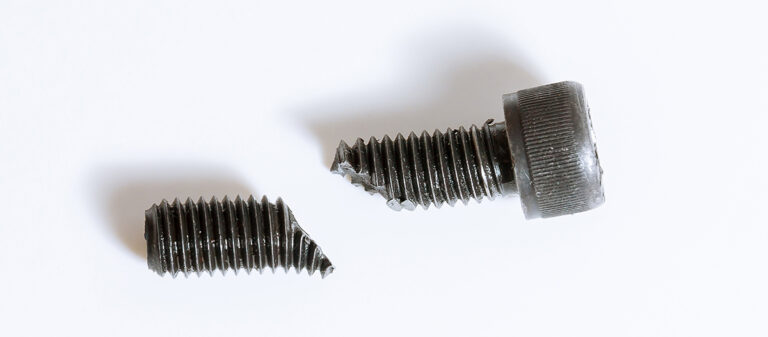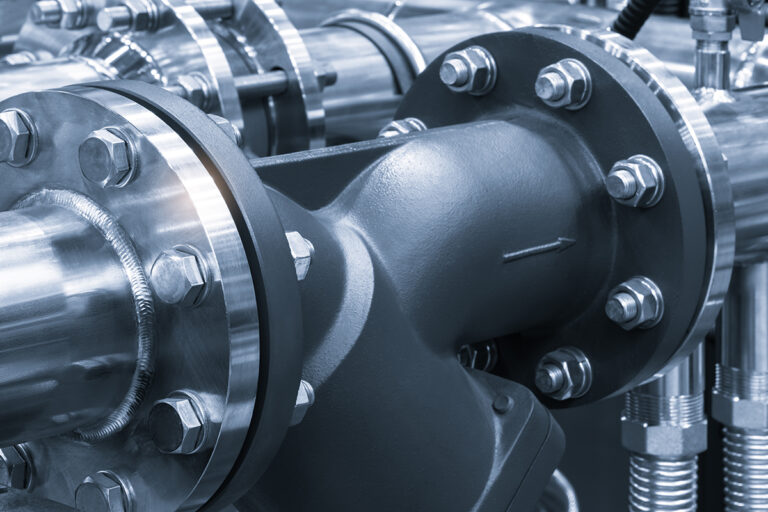Hydrogen embrittlement affects fasteners and is a hidden enemy in engineering – a silent, invisible failure mechanism that can compromise the integrity of fasteners used in everything from aircraft and bridges to pipelines and high-performance machinery. While it may sound like a niche concern, hydrogen embrittlement has caused catastrophic failures in many industries and is something every designer, manufacturer, and maintenance team should understand.
Read on to learn how hydrogen embrittlement affects fasteners, what it is, which materials are most vulnerable, common causes, how to prevent it, how to detect it, and whether it’s the same as corrosion.
What Is Hydrogen Embrittlement?
Hydrogen embrittlement is a process in which hydrogen atoms diffuse into a metal, weakening its internal structure and making it brittle and prone to sudden fracture, often without warning.
The failure typically occurs under tensile stress and results in cracking or rupture at loads below the expected yield strength of the material. What makes it so dangerous is that these failures can happen long after the fastener has been installed, sometimes days or even weeks later.
Which Metals Are Most Vulnerable?
Hydrogen embrittlement primarily affects high strength metals, particularly:
- High Strength Carbon Steels
- Alloy Steels
- Martensitic Stainless Steels
- Titanium Alloys
Austenitic stainless steels like 304 or 316, copper alloys, and aluminium are generally more resistant because of their ductile, face cantered cubic structure (FCC), which is less prone to crack propagation from hydrogen.
Common Causes of Hydrogen Embrittlement
Hydrogen atoms can enter the metal during manufacturing, handling, or in service conditions. These atoms diffuse into the metal’s crystal structure, often settling at areas of high stress or around defects. Over time or under stress, the hydrogen weakens the metal by promoting crack initiation, reducing ductility and toughness that leads to sudden, brittle failure without much warning. Common sources include:
Manufacturing Processes:
- Electroplating (zinc, cadmium, nickel, etc) – hydrogen is generated at the cathode and absorbed into the part.
- Pickling and Acid Cleaning – exposes metal surfaces to acid and introduces hydrogen.
- Welding and Brazing – can trap hydrogen in the heat affected zone.
- Cold Working or Forming – increases susceptibility if hydrogen is present.
In Service Conditions:
- Corrosive Environments – especially with galvanic or acidic corrosion.
- Hydrogen Gas Exposure – common in chemical, oil, and gas industries.
- Cathodic Protection Systems – over protection can lead to hydrogen evolution on metal surfaces.
Signs of Hydrogen Embrittlement
The signs can be subtle and often appear only when a component is under load or stress. Here’s what to look out for:
Visible & Structural Signs
1. Unexpected Cracking or Fracture
- Cracks may appear suddenly and without warning, often under normal loads.
- Fracture surfaces typically look brittle, even if the material is usually ductile.
2. Delayed Failure
- Parts may pass initial inspections or function normally at first, then fail after hours or days under stress.
3. Surface Cracks
- Fine, shallow cracks visible on the surface (especially in plated or high strength steel parts).
- These cracks often form near notches, welds, or stressed regions.
Mechanical Symptoms
1. Reduced Ductility
- Material bends or deforms much less than expected, feels ‘snappy’ instead of flexible.
2. Lower Fatigue Life
- Cracks develop sooner than expected under cyclic loading.
3. Reduced Load Carrying Capacity
- Components may fail under loads they were originally designed to withstand.
How To Prevent Hydrogen Embrittlement
Prevention starts with design and material selection but also relies heavily on process control. Here’s how to reduce the risk:
Material Selection:
- Use lower strength steels when feasible
- Prefer materials resistant to Hydrogen Embrittlement like austenitic stainless steels, aluminium, or bronze for critical applications.
Surface Treatments:
- Avoid acid cleaning where possible.
- Choose non electrolytic coatings like zinc flake systems instead of electroplated coatings.
- If plating is necessary, always follow with a bake out heat treatment.
Stress Control:
- Avoid excessive tightening or preload.
- Design joints to distribute loads evenly and minimise stress concentrations.
How To Check for Hydrogen Embrittlement
Because hydrogen embrittlement is difficult to detect visually, testing is essential – especially for fasteners in safety critical systems.
Detection Methods:
- Hardness Testing – very hard parts are more susceptible.
- Sustained Load Testing – applying a constant tensile load over time to see if failure occurs.
- Fractography – using a scanning electron microscope (SEM) to examine fracture surfaces for intergranular or transgranular cracking.
- Non-Destructive Testing (NDT) – such as dye penetrant or ultrasonic testing, can help identify surface and sub-surface cracks.
Early failure of fasteners in a batch may be a red flag indicating hydrogen embrittlement.
Is Hydrogen Embrittlement the Same as Corrosion?
Hydrogen embrittlement and corrosion are not the same, although they are sometimes related.
Corrosion is a chemical reaction, typically involving oxidation, that degrades the metal surface over time. Whereas Hydrogen embrittlement is a mechanical failure caused by the diffusion of atomic hydrogen into the metal lattice, often exacerbated by corrosion.
In some cases, corrosion produces hydrogen as a by-product (especially in acidic or galvanic corrosion), which can then lead to hydrogen embrittlement. So, while they’re different, once can cause or accelerate the other.
Real World Examples
Aerospace Industry: High strength landing gear bolts have failed due to poor plating and inadequate baking procedures.
Bridges: Suspension bridge cable fasteners have fractured after years in corrosive environments, traced back to hydrogen ingress during fabrication.
Automotive: Torque-to-yield bolts in engines and suspensions have cracked after hydrogen-rich manufacturing steps without proper heat treatment.
Final Thoughts
Hydrogen embrittlement is one of those hidden dangers in engineering that often goes unrecognised – until something breaks. Whether you’re designing structural bolts for a skyscraper, precision screws for an aircraft engine, or pressure vessels for the chemical industry, understanding how hydrogen embrittlement affects fasteners is crucial.
A single overlooked step in manufacturing or maintenance can lead to delayed, sudden, and catastrophic failure. But with knowledge and the right precautions, hydrogen embrittlement can be managed and prevented.
Our team of experts are ready to assist you in choosing the most suitable security screws for your specific requirements.
Contact us today on 1800 776 565.
Secure Your Assets with Sentinel Group Security Screws.
Choose Sentinel Group Security & Customised Fastening Solutions.




